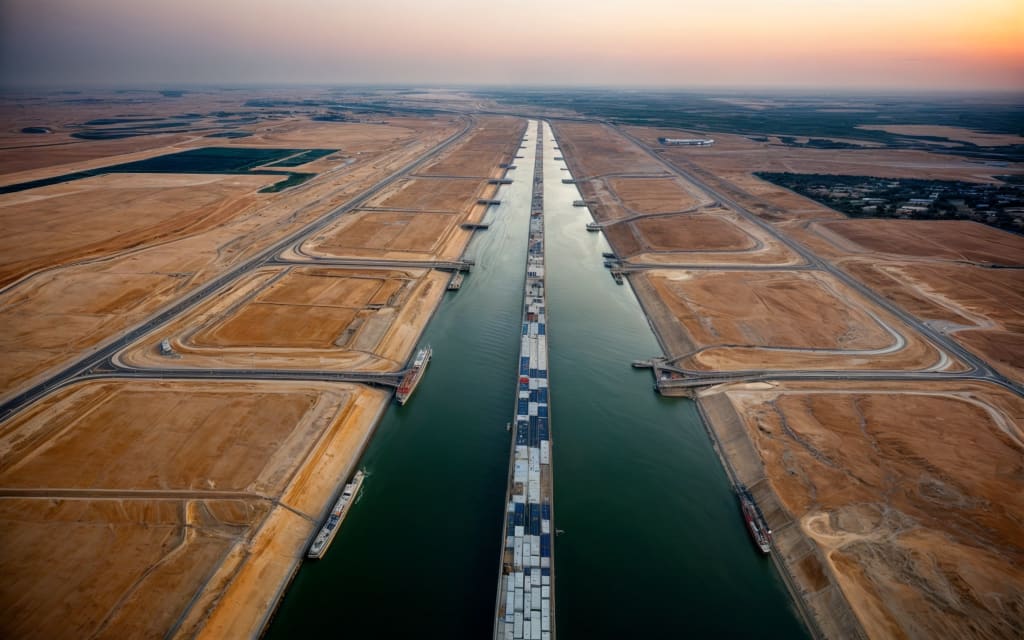Twin Troughs Suez and Panama Canals
Suez and Panama Cannals

Twin Box: Suez and Panama Channels
The sun cast a brilliant tint over the immense territory of water as it rose, welcoming the two fantastic accomplishments of human design: the Suez Channel and the Panama Trench. However isolated by huge numbers of miles and various scenes, these two waterways shared a typical bond, for they were the help of worldwide exchange, twin boxes interfacing far off seas.
The Suez Channel: A Story of Diligence
The tale of the Suez Trench started during the nineteenth century in Egypt, a land saturated with old history. It was here, amid the sands of the Sinai Landmass, that a visionary French negotiator and specialist named Ferdinand de Lesseps hoped for an easy route between the Mediterranean Ocean and the Red Ocean. The current course around the Cape of Good Expectation was hazardous and extended, and de Lesseps accepted that a channel through the Isthmus of Suez would change exchange.
Development started in 1859, with a great many workers persevering through burning intensity and unforgiving circumstances. The undertaking confronted various difficulties, from monetary troubles to flare-ups of infection. However, de Lesseps' faithful assurance kept the vision alive. Following 10 years of tireless exertion, the trench was at long last finished in 1869, a sparkling lace of water slicing through the desert.
As the primary boats explored this new entry, the world saw a change in shipping lanes. The Suez Channel turned into a vital supply route for business, decreasing travel time between Europe and Asia by weeks. It was an image of human creativity, a demonstration of the conviction that even the most aggressive dreams could be acknowledged through determination.
The Panama Waterway: Spanning Two Seas
Most of the way across the world, another stupendous undertaking was coming to fruition. In focal America, the thick wildernesses of Panama disguised a limited portion of land that isolated the Atlantic and Pacific Seas. For quite a long time, travelers had fantasized about a channel that would connect these two extraordinary waterways. The fantasy, in any case, stayed unfulfilled until the mid-twentieth century.
The French had endeavored to build a waterway in Panama during the 1880s, yet the task was deserted because of monetary fumbles and widespread tropical illnesses. The mantle was then taken up by the US, under the initiative of President Theodore Roosevelt. Still up in the air to succeed where others had fizzled, the Americans started work in 1904.
The development of the Panama Canal was a huge endeavor. Engineers confronted imposing difficulties, including avalanches, intense intensity, and the dangerous hazard of intestinal sickness and yellow fever. Developments in clinical science and design practices played an essential part in conquering these snags. Dr. William Gorgas' endeavors to control mosquito populations radically diminished illness, while the presentation of gigantic lock frameworks permitted boats to navigate the fluctuating rises of the isthmus.
Following 10 years of tenacious work, the Panama Trench opened in 1914. It was a wonder of the current design, with ships from around the globe arranging to navigate its waters. The waterway not only abbreviated the sea venture between the east and west shores of the US but additionally turned into a crucial conductor for worldwide exchange, connecting the Atlantic and Pacific Seas in a manner that had once appeared to be unthinkable.
Twin Boxes of Worldwide Exchange
Today, the Suez and Panama Waterways stand as twin boxes, symbolic of human determination and advancement. They are something other than streams; they are doors that have molded the course of history, interfacing with societies, economies, and the mainland. Ships weighed down with merchandise from each edge of the globe skimmed through their waters, demonstrations of the visionaries who hoped for a more associated world.
In the clamoring ports on one or the other side of these waterways, the tales of endless journeys meet. The Suez and Panama Waterways are living heritages, updates that when humankind focuses not too far off, there is no snag too perfect, no distance excessively far. Through them, the world has turned somewhat more modest, and the conceivable outcomes, as tremendous as the seas they join together, are unending.
__________________________________________
Thank you so much for reading this! 🥰 If you liked my writing, please leave a comment, click the heart and subscribe for free!
You might enjoy this as well:
About the Creator
Rony Sutradar
I am an experienced writer who produces sharp, convincing writing for exciting startups, household names and everything in between. On a daily basis.
Enjoyed the story? Support the Creator.
Subscribe for free to receive all their stories in your feed. You could also pledge your support or give them a one-off tip, letting them know you appreciate their work.






Comments
There are no comments for this story
Be the first to respond and start the conversation.